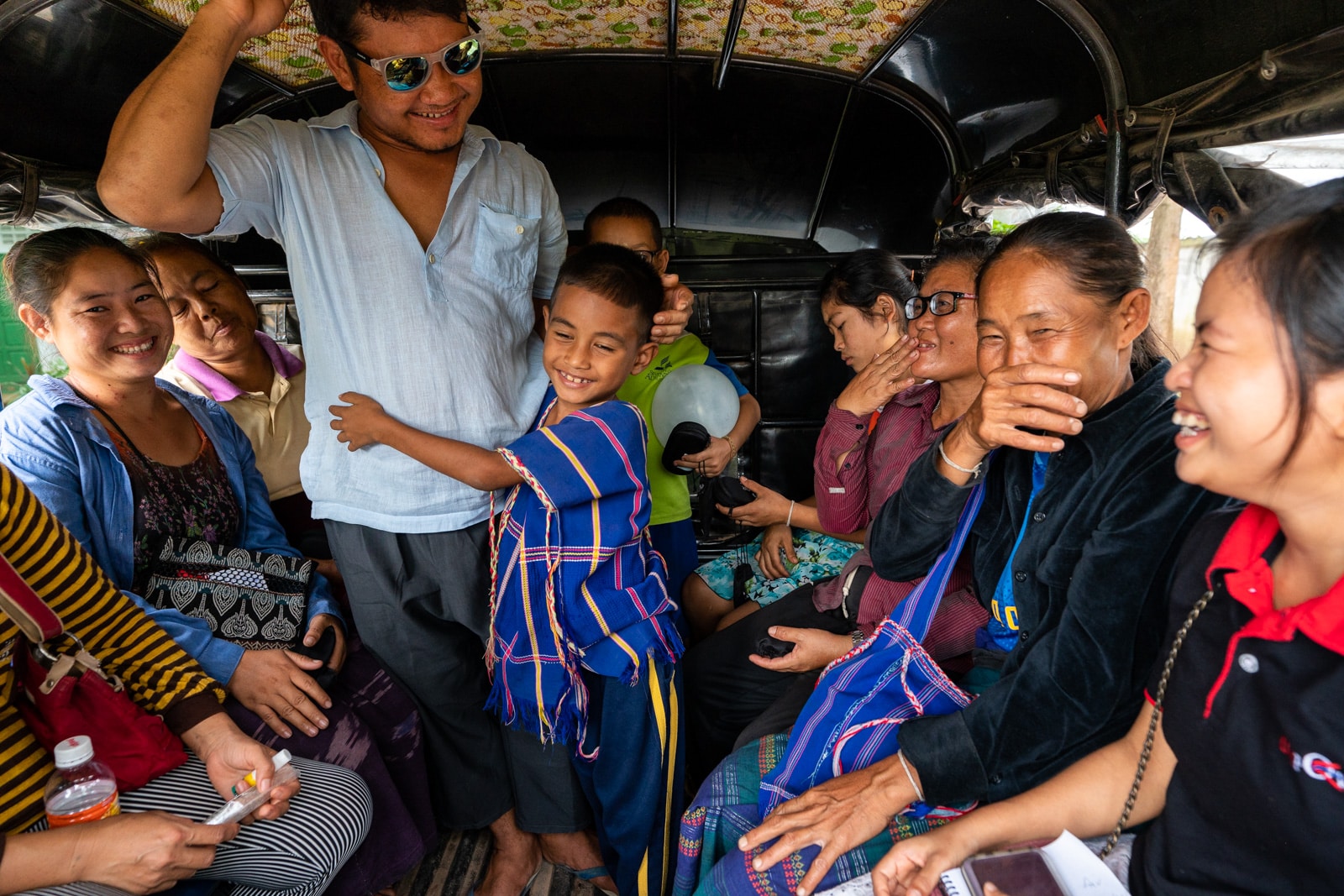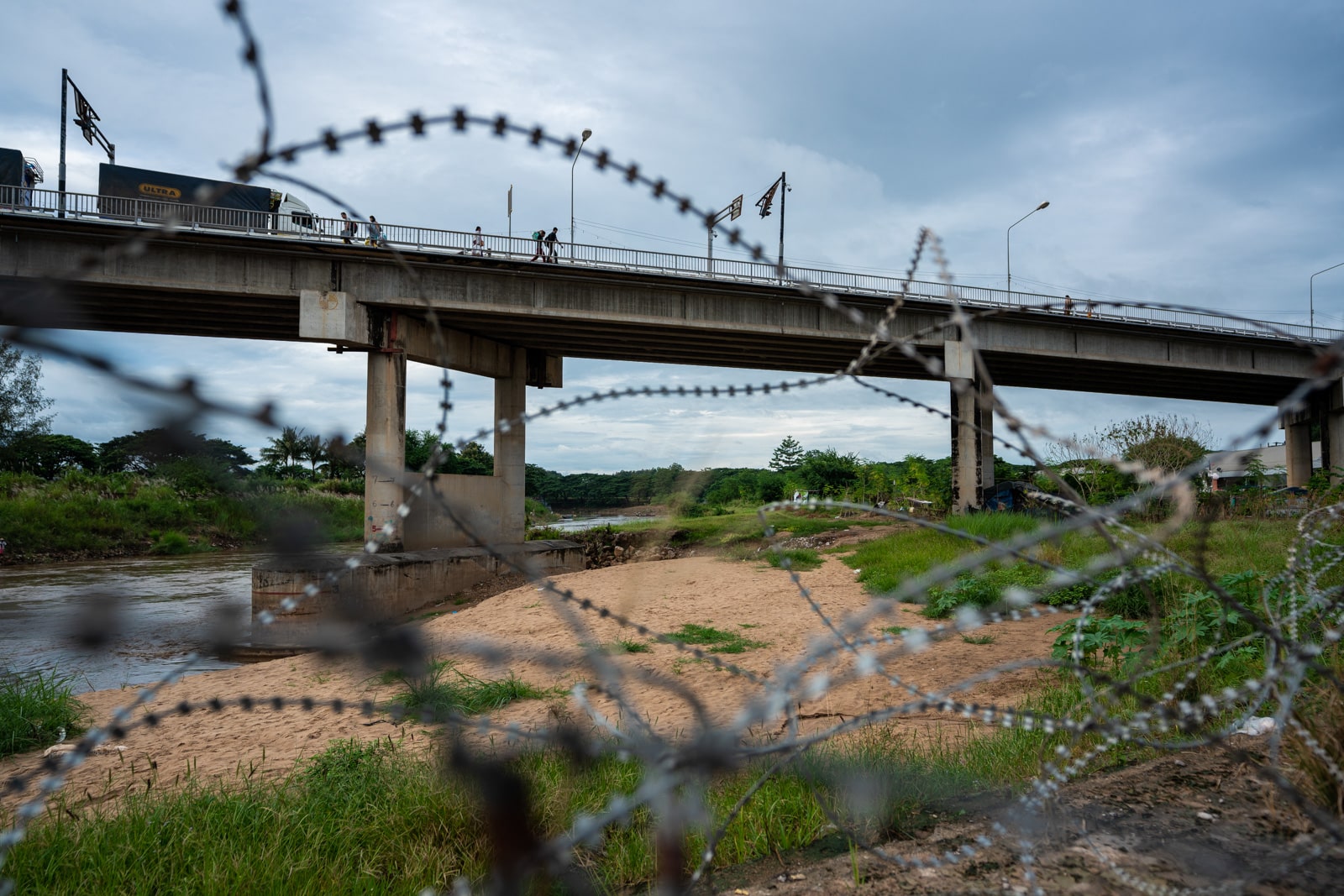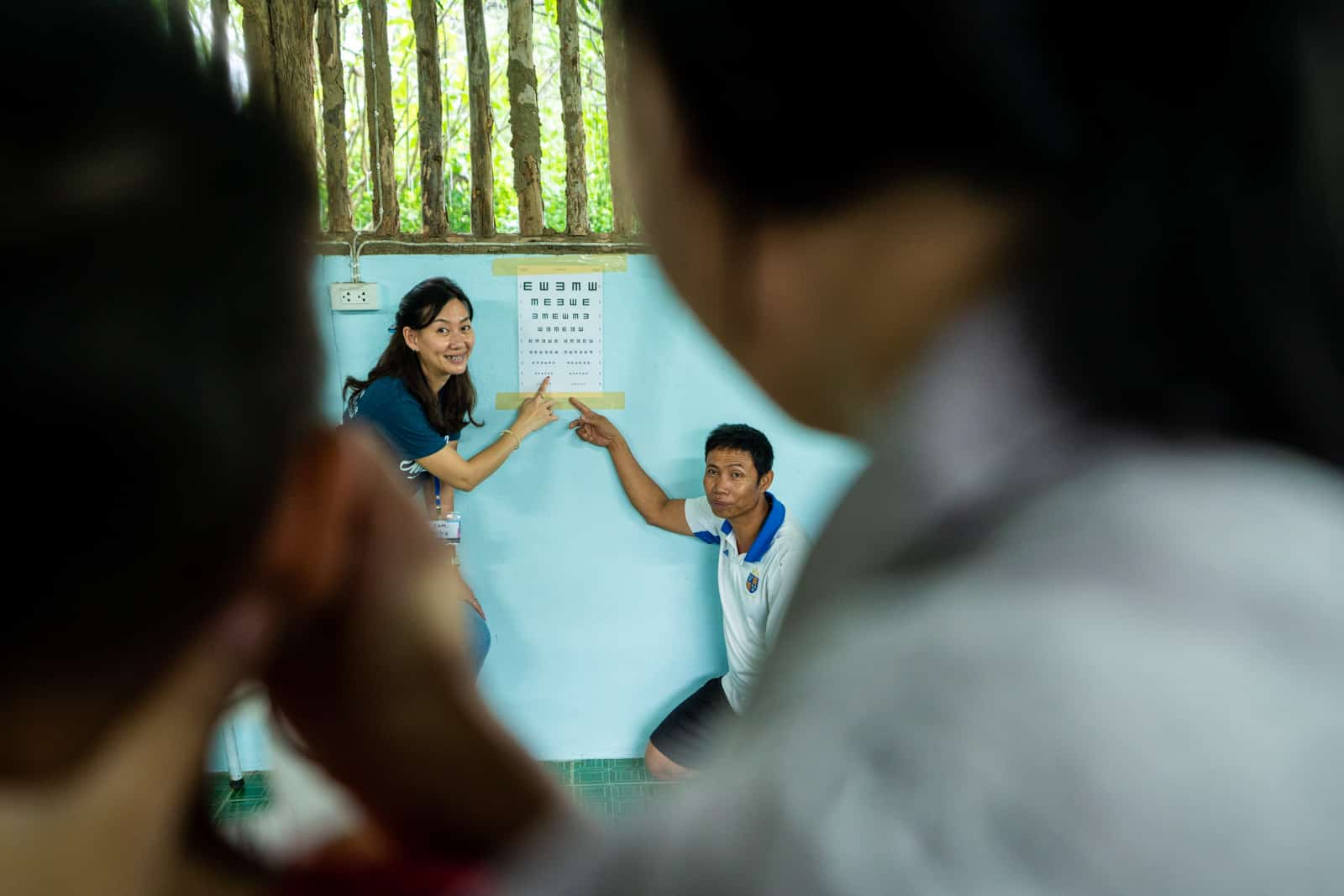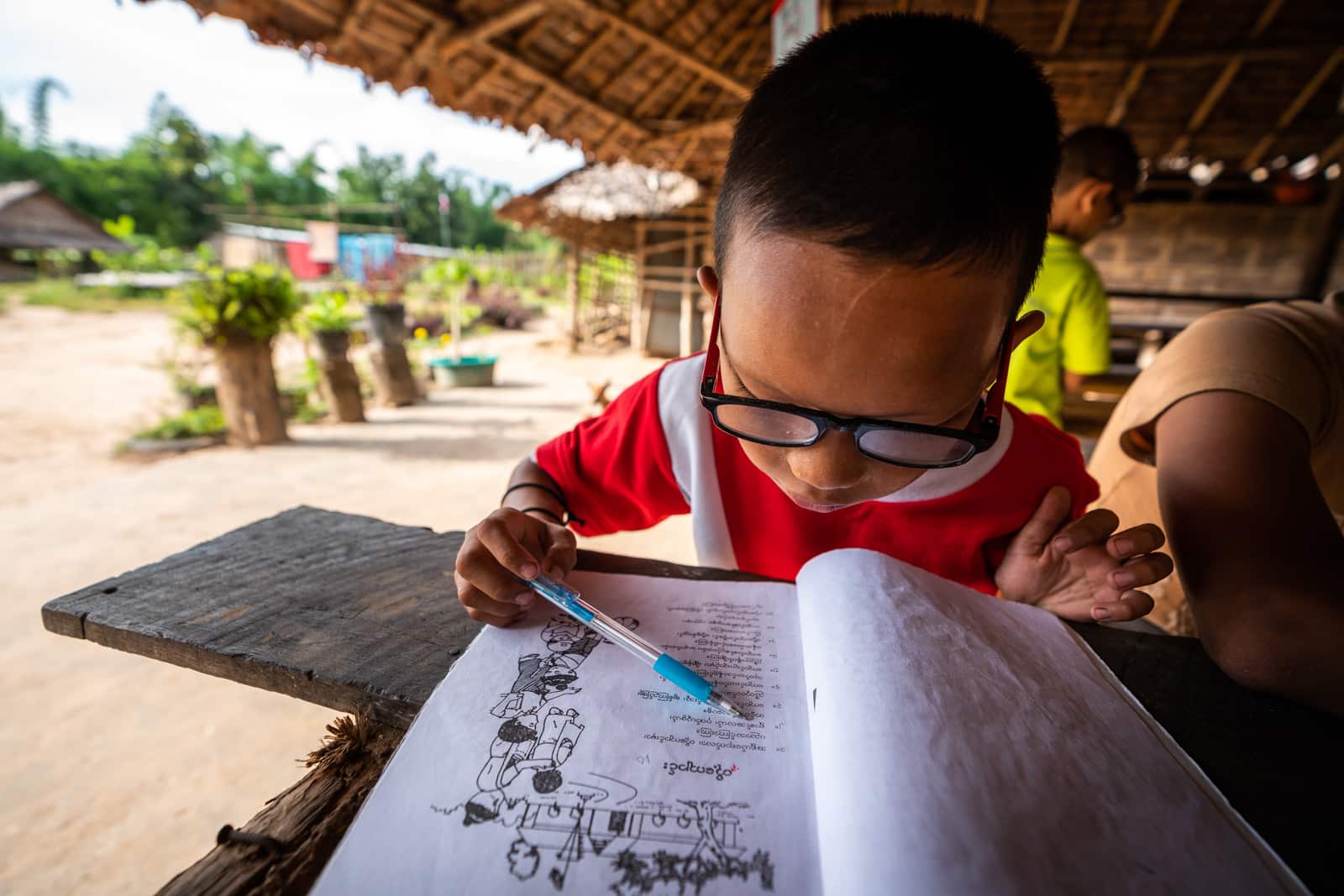The situation on the Thailand-Myanmar border is more complicated than most of us are aware of. Here’s a glimpse into the lives of displaced people along the border… and how OneSight is helping to bring permanent eye care to this region.
8-year-old Sei is squeezed into the back of a pickup truck trundling down a dirt road in rural Thailand. Full of people laughing, dozing, chatting, the truck is on its way back from a free eye care clinic run by the NGO. Sei is excited: he just got his first pair of glasses.
Slightly shy and clad in a bright red sports jersey one size too big, Sei seems like your typical 8-year-old boy. Poring over comics is his favorite pastime, followed closely by football (soccer) and an addiction to a mobile game he calls “Bobo”. He has a ways to go before his job hunt begins, but nevertheless wants to be a language teacher when he grows up.

But there’s more to Sei than meets the eye.
Unlike “typical” boys his age around the world, Sei lives in limbo: he is an internationally displaced person from Myanmar. So are the rest of his companions in the truck.
Some were born within Myanmar, while others were born to migrant parents already in Thailand. All of them now live in Thailand, but few have official status within the country’s borders, and struggle to live as a result.

Inside the truck driving Sei and company back from OneSight’s eye care clinic.
Life on the border’s edge
Around 200,000 people live in situations like Sei’s along the Thailand-Myanmar border. This is their story.
Beginning in the 1980s, Karen people—and other ethnic groups—fled from Myanmar to Thailand to escape violent conflict between Myanmar’s military and minority groups. Now they’re stuck in a state of uncertainty. To stay in Thailand means limited opportunities; to return to Myanmar is to face farmlands filled with mines, no work opportunities, and military violence.
Finding an official, well-paying job is virtually impossible without Thai identification cards, which displaced people generally cannot receive. The same goes for securing a spot in Thai schools or universities: students like Sei instead attend Migrant Learning Centers which have limited staffing and funding.

The Friendship Bridge connects Thailand and Myanmar near the city of Mae Sot. People with official documentation cross using this bridge…

… while hundreds of people without documents ferry to and fro on the river below the bridge each day.

Displaced people living near the river that runs along the border.
Despite the odds, many migrants from Myanmar manage to find housing and work under the table, and maintain relative freedom of movement. But around 100,000 more displaced people live in temporary shelters along the Thailand-Myanmar border.
These shelters provide the basics, but offer limited opportunities to change their status; they are not required to leave, and people can stay their entire lives. Most occupants are afraid to repatriate to Myanmar, while relocation to a third country is a second—and less likely—option. All shelters house several thousand people at least; the largest border shelter has around 40,000 occupants. Some residents have been living in these shelters for more than 30 years.
Access to healthcare is limited for most displaced people, both inside and outside these temporary shelters. Cost of treatment and transportation are some common barriers. Awareness and education are continuing obstacles. For those in temporary shelter communities, the biggest challenge is straightforward: they can’t access outside clinics or hospitals. They must wait for medical care to come to them.

People in a temporary shelter waiting their turn outside OneSight’s eye care clinic.
Clearing a path to good sight
Over the course of two weeks this past October, medical care did come. While it’s a small start, the groundwork is being laid for a long-term solution.
OneSight—the vision care NGO which you may recall from my eye clinic experience in the Brazilian Amazon earlier this year—is one of several organizations working to bring medical care to all displaced people stuck in the border region. I traveled to several locations with them to photograph and document their first charitable eye clinic along the Thailand-Myanmar border.
The clinic in the border region was a success. More than 2,000 patients were screened in several different locations. Thanks to OneSight and local organizations working with them —Essilor Vision Foundation, Mae Tao Clinic, Top Charoen, and more—more than 1,700 of those patients received glasses, most of them on the day of their visit. Totally free of charge.

Sei getting his new glasses fitted on the spot.
But there’s more to the clinics than patient volume and data. Each of the patients has a story to tell, a need to be met. Some came from within Thailand’s borders; others traveled from Myanmar across the border specifically for an eye exam. Despite risk to both their well-being and resident status, a desperate need for eye care drove many of them to OneSight’s clinic to receive something so many of us take for granted: vision.

I watched men who lost eyesight to violence or accidents years ago finally get medicine they need for their injured eyes, and glasses to protect their good eyes.

Smiled as a practically blind rice farmer who’d never had glasses before saw clearly for the first time.

Grinned as delight spread across faces of those who believed any pair of glasses from the market would correct their vision, when they received their first pair of glasses created just for them.

Saw extra pairs of glasses given to an extremely nearsighted nurse who’s only owned 2 pairs of glasses in her entire life.

Felt hope as students of all ages got the prescription they needed to see letters on a board or text in a book.
But these stories are hopeful beginnings, not just happy endings.
Looking to the future of the border region
In just two weeks, OneSight gave high quality vision care to over 2,000 displaced people who made the trek to the clinics. A number to be proud of, but it’s just one percent of the estimated 200,000 displaced people living along the border who don’t have access to vision care. Charitable clinics like this one make an undeniable difference, but they’re not a sustainable long-term solution.
Just as responsible travel is much about empowering local communities to support themselves, OneSight is approaching this region with the hopes of empowering people to help themselves. Give a man to fish, and he can eat for a day. Teach a man to fish, and you feed him for a lifetime.
But how? During OneSight’s border clinic, in addition to screening patients, OneSight’s doctors trained Refractionists at the Mae Tao Clinic. Responsible for determining eye prescriptions so glasses can be made, the Refractionists previously received five months of training from OneSight and Essilor eye doctors. This clinic was their final exam.
Now they’re officially certified Refractionists, and will be able to screen patients and provide glasses for any patients who can make it to Mae Tao Clinic. Even when OneSight is gone.

After improving her skills during OneSight’s week-long clinic, Tamlawah is now a certified Refractionist at the Mae Tao Clinic.
OneSight is also training people at the Migrant Learning Centers and the temporary shelters to pre-screen students and community members for vision problems. Rather than rely on OneSight to pre-screen for patients before clinics, these trainees will be able to pinpoint people who need treatment or glasses early on. Those in need will receive a referral so they can then go to the free Mae Tao Clinic for a complete screening and prescription glasses if needed.

A OneSight volunteer and a local teacher doing an eye exam at a Migrant Learning Center.
There’s more to OneSight’s strong start on the Thailand-Myanmar border than just giving out glasses; they’re spreading hope among the approximately 200,000 people with limited opportunities. Eye care and glasses bring opportunity and a positive outlook to the community. Training provides clarity of purpose to the newly minted Refractionists, enabling them to carry on the positive changes OneSight began.
But these changes won’t happen overnight. This past clinic was the spark of a three-year flame aimed at bringing brighter vision to all of the displaced people along the Thailand-Myanmar border by 2020. The ball is in motion—let’s keep it going.
Want to learn more or donate to OneSight’s Thailand-Myanmar border project? You can do so on their website here.

Yay transparency! Names have been changed to protect the identities of the people involved. OneSight compensated me for my work at the clinic… however, I think it’s pretty clear that this is a project worth believing in, and all opinions are most definitely my own.



Another awesome blog and i find more new information, i like that kind of information, not only I like that post all peoples like that post, because of all given information was very excellent.
I really like your blog posts and information.
Wow, nice blog…!!! It is very helpful information. So thank you for sharing……!!!!!!!!!!!
Hi Alex,
Nice post. You are giving a good description of the situation along the Thai-Burmese border.
I wish that you had mentioned how the Thai police and authorities are taking advantage of the Burmese refugees fragile situation. They are extorting money at roadblocks, along the road North of Mae Sot leading to the refugee camps. There are stories of women who where harassed, even raped….
Right across the Thanlyin river, on the Burmese side, Karen freedom fighters are training in the hope to defeat the Burmese army one day and regain independence in the Karen state:
http://esimanor.wixsite.com/esimanor-photography/karen-freedom-fighters
Best,
Eitan
Thanks for sharing your photos Eitan, they’re really striking and present much more depth into the situation.
Enyoyed your writing very much
What a blog ,whith interested in people and country
@eitan. you might be happy to read that these karen rebels are also supported by a handful of foreigners–most former soldiers themselves–from ukraine, france, usa and other nations.
foreign fighters will not usually fight at the frontlines but do provide advanced (material) training, combat training and logistical support.
the most organized foreign group are the Free Burma Rangers (FBR) whom are also well equipped are very respected among everyone. besides FBR there are another handful of foreigners who have their own klandestine operations going on.
@alex one of your photos is about 40 minutes on foot away from a burmese militia station, located within thai soil, where mae la residents who are wanted by tatmadaw get kidnapped/abducted to. this checkpoint is aggressive when it comes to drawing weapons on approaching “visitors” but if youd like i could pass you the gps coordinates. it is possible to monitor it by drone from above.
These are really very best things you shared and beautiful pictures you capture. xoxo Mahima (A link was deleted from this comment because it wasn’t relevant – admin)
Dear Alex!
In this way I like to thank you for your wonderful Blog, the chance to participate in your travelling experience, which is so different to 90% of all the other blogs!
All that I read and seen until now is amazing and I really appreciate your Photos and hope that you can find a way to publish them also in another way, maybe a book. There are so many outstanding photos, so near the truth and not the 4 colour travel guide „paradise“ you could find anywhere.
Please go on your way as a tough young women that is able to care and share about a different view to our wonderful Planet!
With best regards from Berlin
Micha
Who isn´t any more able to travel this way about the age and a physical handicap, so almost more happy to found your blog
Thank you for the kind words, Micha! Happy to help you travel virtually 🙂 I try to look beyond glossy postcard imagery, but as a traveler I can’t deny it’s still a challenge to go beyond the surface, despite what we like to think.